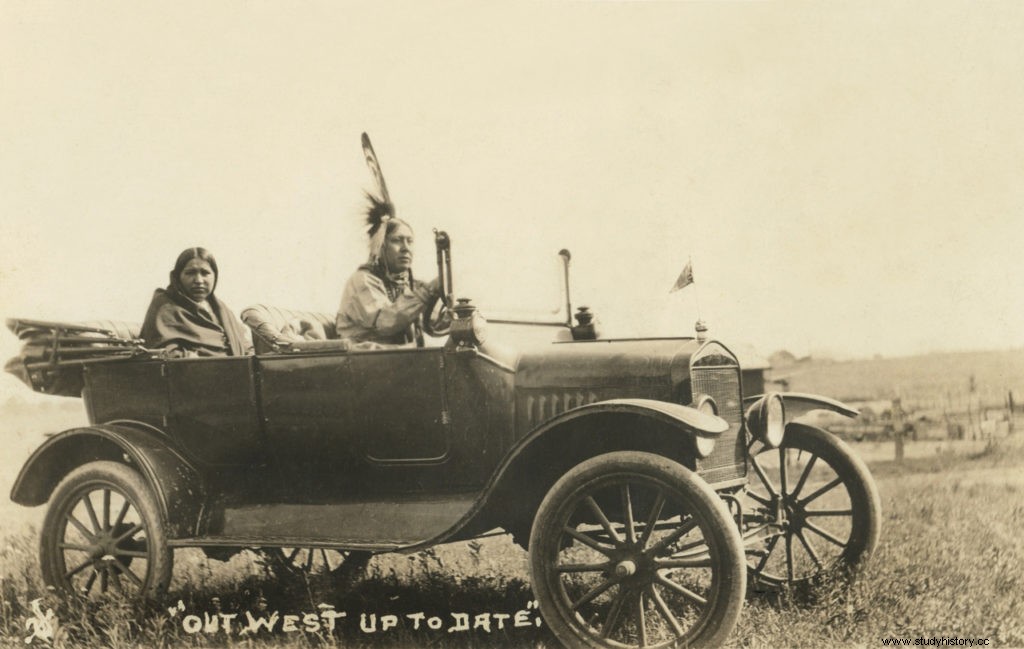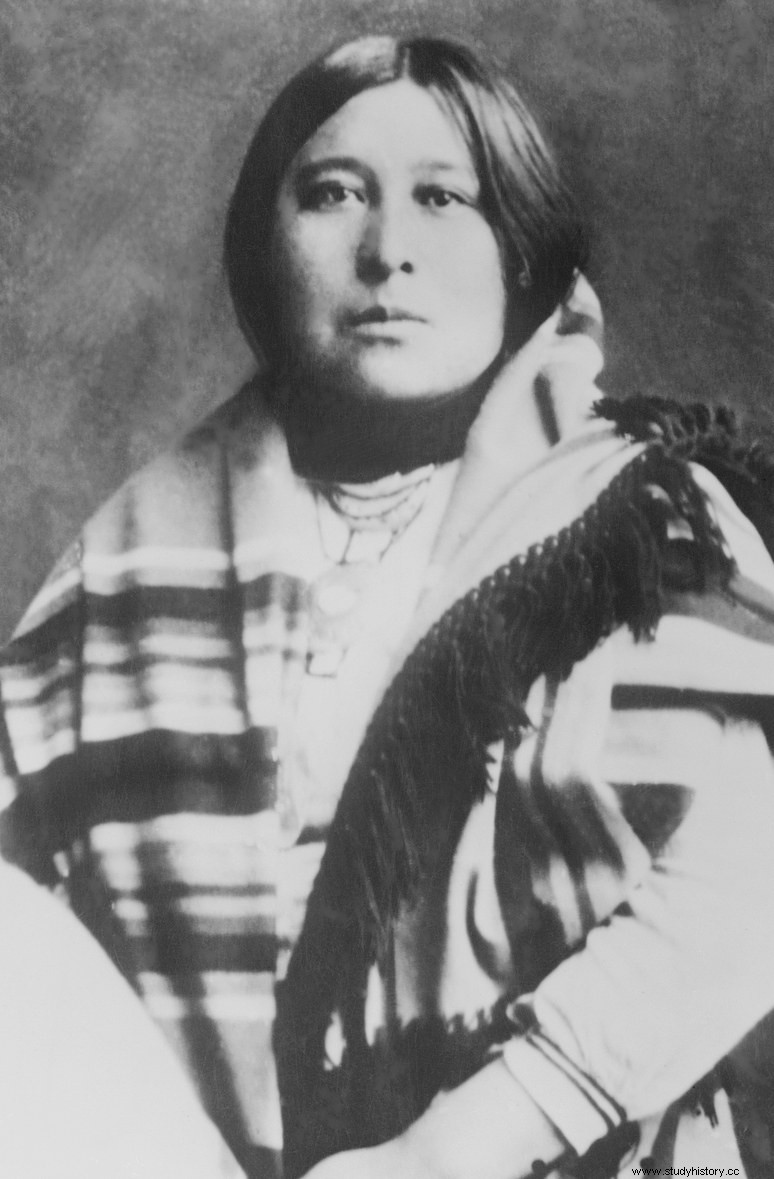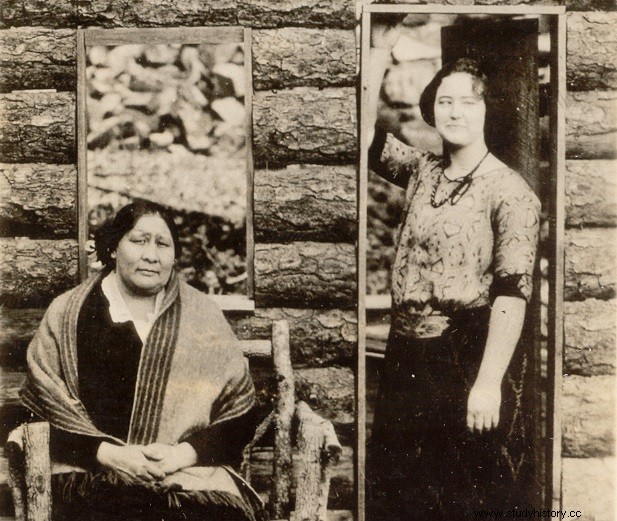A member of the Osage people, Mollie Kyle Cobb (1886 – 1937) is a witness and a survivor of the "Reign of Terror", a wave of murders that decimated her people in order to steal their wealth.
The Osage people

Originally from the Great Plains of North America, the Osages call themselves “Wazházhe” or “children of the middle water”; the middle water designating the Osage River, a sub-tributary of the Mississippi which crosses the territory of the tribe. The name Osage comes from a French deformation due to French trappers and trappers and French Canadians.
The Osages are not spared from the Conquest of the West. Decimated by smallpox epidemics, in the 19th century they were forced to give up their traditional lands and deported to arid territories in the north of the state of Oklahoma in the United States. Compensated for the cession of their lands, they are one of the rare tribes able to buy their reservation, but the almost uncultivable ground which one allotted to them condemns them initially to the famine.
Their situation changed completely from 1897, when the largest oil field in the country was discovered on their territory. Overnight, the Osages, whose territory has been divided into 2,229 equal parts among the members of the tribe, find themselves rich in the millions. They build themselves huge houses, buy luxury automobiles, hire servants. A sudden opulence which is not without stirring up greed and jealousy. In 1921, wanting to control how the Osages spent their wealth, the United States Congress passed a law requiring anyone of half Osage descent or more to place themselves under the responsibility of a guardian, until they could prove their own abilities.
Mollie and Ernest

It is in this context that Mollie Kyle Cobb was born and grew up. Daughter of Lizzie Q. Kyle, she was born on December 1, 1886, a member of the Osage tribe by both parents and as such assignee of one of the 2,229 plots of the reserve. Mollie grew up between two worlds, raised in white schools and largely cut off from the culture of her people. It is from this education that the name of Mollie comes to her, like those of Minnie, Rita and Anna for her sisters.
In 1912, young Ernest Burkhart, nephew of wealthy and influential rancher William Hale, moved in with his uncle in the area. Working primarily for Hale, Ernest sometimes acts as a driver and drives Mollie around town. The young woman falls in love with him and, despite the mockery of Ernest's friends who call him "squaw man ”, the two married in 1917. These mixed marriages were not so unusual for the Osages; Mollie's three sisters had also married white men. Children, Elizabeth and James, were soon born of their union.
But Mollie's happiness will not last. In 1921, a few years after their marriage, the first murders began.
Time of the flower-killing moon
In April, the hills of Osage Territory in Oklahoma are covered with thousands of small spring flowers that make it seem, as Osage writer John Joseph Mathews would write, “the gods left confetti.” In May, at the full moon, taller plants grow and steal light and resources from small flowers. Their petals wither and fall off. This is why the Osages speak of May as the time of the flower-killing moon.
It is a day in May that Anna Brown, the sister of Mollie Kyle Cobb, disappears. It was another day in May, a week later, that his body was found in a ravine, with a gunshot wound to the head. The autopsy conducted by the local authorities, however, concluded that he died accidentally, a fall linked to excessive alcohol consumption. The last person to see Anna alive, Byron Burkhart, Ernest's brother with whom Anna had a relationship, says he knew nothing and did nothing; the investigation goes no further.
The same day, Charles Whitehorn, a cousin of Anna and Mollie, is also found dead, shot dead. Bereaved, Lizzie and her daughters also see their fortunes grow. Lizzie, who lives with Mollie, inherits Anna's shares, which are added to those of her husband and her daughter Minnie, who died of illness three years earlier.
Reign of Terror
The killings don't stop there. Two months later, it is Lizzie's turn to die in suspicious circumstances; his daughters, Mollie and Rita, inherit a veritable fortune. In 1923, another cousin of Mollie, Henry Roan Horse, was found shot in the head. The same year, a bomb pulverized the house of Mollie's sister. Rita and her maid Nettie Brookshire die instantly; Bill Smith, her husband, died a few days later. Mollie is now the sole survivor of her family, and the head of a considerable fortune.

But the "reign of terror", as the Osages call this period, is not over. In June 1923, George Bigheart was taken to hospital where doctors suspected he had been fed poisoned whiskey. Lawyer William Watkins Vaughan is called to the scene; both men die the next day. Vaughan, who was to leave by train, is found brutally murdered near the railway tracks. Month after month, year after year, the names of the Osages killed are scattered:William Stepson, Joe Yellow Horse, Henry Benet, Hugh Gibson... The number of victims is still debated to this day, but not a month goes by without an Osage is assassinated, without a fortune changing hands.
The Bureau of Investigation
Faced with the passivity of the local authorities in the face of the massacre of their people, the Osage tribal council asks for help from the federal government. A few weeks later, the young "Bureau of Investigation", founded in 1908 by Roosevelt, launched a major investigation. Four agents, led by former Texas Ranger Tom White, are sent undercover into Osage territory for a two-year investigation. Upon arriving, the agents discover a complex situation and an unfavorable context. Terror binds tongues, both among the Osage and the white community, and at first no one seems willing to collaborate with the Bureau.
The Bureau is particularly focused on the murder of Henry Roan Horse, who was murdered within the boundaries of the Osage reservation, making it a federal crime. Quickly, and like the Osage council, they suspect wealthy rancher William Hale, Ernest's uncle. Henry Roan had a debt of $1,200 to the breeder, and he had made him the beneficiary of life insurance. But Hale, who calls himself "King of the Osage Hills", is a wealthy, powerful and influential man in the region, and no one testifies against him.
The names of Ernest Burkhart and John Ramsay, a local cowboy, come up in the investigation. Interrogations end up pushing the suspects to accuse each other:John Ramsay confesses to having been paid by William Hale to kill Henry Roan. The rancher turns out to be the one pulling the strings, leading a plot involving his nephews and numerous henchmen. Ernest, Mollie's own husband, pleads guilty to his part in the murders of the Kyle family members; Mollie was next on the list. When the suspects are arrested, she is seriously ill and discovers that she is being gradually poisoned. Away from the killers, she survives and recovers.
After the terror
The trials of Ernest Burkhart, John Ramsay and William Hale, which received extensive national media coverage, took place between 1926 and 1929; the three men are found guilty and sentenced to life in prison. Byron Burkhart, who participated in the murder of Anna Brown, escapes the trial by testifying against his accomplices. Already imprisoned, a William Hale henchman named Kelsie Morrison was found guilty of murdering Anna Brown and also sentenced to life in 1926. Other accomplices died before being tried.
The Bureau, which will become the FBI, considers the case a success that allows it to establish its legitimacy and credibility. However, other suspicious deaths surfaced during and after the trials, and many murders of the "Reign of Terror" remained unsolved. To stop the machine, a federal law is passed to prohibit non-Osage from inheriting parcels belonging to members of the tribe who are more than half Osage.
Despite the impact of the arrests and the trials, and despite the protests of the Osages, the three murderers will be released after more or less long prison sentences; Ernest Burkhart will receive a pardon from Oklahoma Governor Henry Bellmon in 1965.
“A friend for all”
Sole survivor of the conspiracy that took away her family, recovering from her poisoning, Mollie Kyle Cobb divorces her criminal husband. She will later remarry John William Cobb, Jr. Raised between two worlds, she then seems to have been sidelined in these two worlds. Loyal to Hale, white people reject her, while some Osages blame her for bringing the killers into their midst.
Mollie Kyle Cobb died in June 1937, at the age of 50, leaving his fortune to his children. Her grave bears the following epitaph:“She was a kind and affectionate wife and a fond mother and a friend to all. » (“She was a kind and loving wife, a loving mother, and a friend to all.”)
